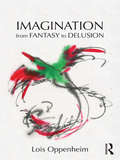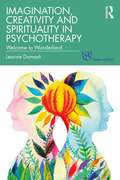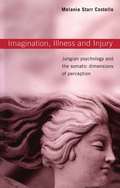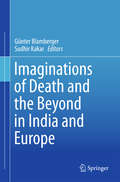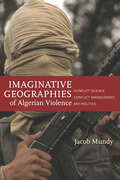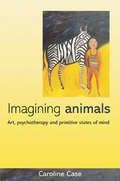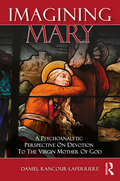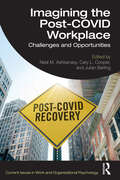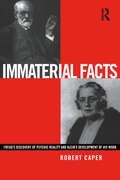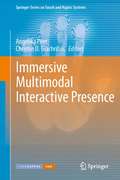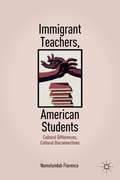- Table View
- List View
Imagination from Fantasy to Delusion (Psychoanalysis in a New Key Book Series)
by Lois OppenheimIn Imagination from Fantasy to Delusion, Lois Oppenheim illustrates the enhancement of self that creativity affords, the relationship of imagination to the self as agent. The premise of this book is twofold: First, that the imaginary is real. Where it differs from what we commonly take to be reality is in structure and in form. The imaginary of art, for example, is not illusionary for it is phenomenologically describable and even depictable, as demonstrated by the self-reflexive efforts of modernist painters and writers. No less real than the imaginary of art, and thus fantasy, is the imaginary of delusion, ascertainable in the very function it serves. Though fundamentally different, fantasy and delusion do share a significant feature: a preoccupation with agency. Second is that change, the enhancement of self through an increase in agency, is facilitated by the biology of reward: The pleasure of increased self-cohesion—the efficacy acquired through knowledge of, and the attribution of meaning to, the world—is ultimately the sine qua non of imaginative thought. Oppenheim emphasizes the idea that imagination generates knowledge. Our sensory systems, like our higher cognitive functions, give the human brain knowledge to maintain the homeostatic balance required for survival and to enrich the sense of self required for agency. And, she suggests, imagination is a function of their doing so. Moreover, she explores the construct by which we apprehend the workings of imagination—fantasy—and considers in what the mental imagery that endows it consists, how fantasy may be transmitted transgenerationally, and how delusion can be an impediment to imagination while also being a product of it. Additionally, she likens psychoanalysis to the making of art as a process of acquiring knowledge and looks at creativity itself as a coming-to-know. Throughout this book, there run several opposing threads. The first is that of the intra- and interpsychic psychoanalytic paradigms. This theoretical contrast bears on our understanding of aesthetic experience as sublimatory versus object relational and on our understanding of the construction of meaning. A second opposition resides in the notion of agency (with its implication of self-cohesion) which has everything to do with ego function and, seemingly, the usefulness of "unconscious fantasy," a cornerstone of psychoanalysis now thrown into question by the postmodern favoring of dissociation over repression and other mechanisms of defense. Last, but no less significant, is the contrast interwoven between the empiricism of neuroscience and the metaphysics of philosophical thought. Oppenheim's underlying effort is to explore the validity of these oppositions, which seem not to hold as steadfastly as we tend to suppose.
Imagination in Human and Cultural Development (Cultural Dynamics of Social Representation)
by Tania Zittoun Alex GillespieThis book positions imagination as a central concept which increases the understanding of daily life, personal life choices, and the way in which culture and society changes. Case studies from micro instances of reverie and daydreaming, to utopian projects, are included and analysed. The theoretical focus is on imagination as a force free from immediate constraints, forming the basis of our individual and collective agency. In each chapter, the authors review and integrate a wide range of classic and contemporary literature culminating in the proposal of a sociocultural model of imagination. The book takes into account the triggers of imagination, the content of imagination, and the outcomes of imagination. At the heart of the model is the interplay between the individual and culture; an exploration of how the imagination, as something very personal and subjective, grows out of our shared culture, and how our shared culture can be transformed by acts of imagination. Imagination in Human and Cultural Development offers new perspectives on the study of psychological learning, change, innovation and creativity throughout the lifespan. The book will appeal to academics and scholars in the fields of psychology and the social sciences, especially those with an interest in development, social change, cultural psychology, imagination and creativity.
Imagination in the Western Psyche: From Ancient Greece to Modern Neuroscience (Research in Analytical Psychology and Jungian Studies)
by Jonathan EricksonImagination in the Western Psyche: From Ancient Greece to Modern Neuroscience offers a comprehensive treatment of the human imagination by integrating the rich discourse on imagination in the humanities with modern neuroscientific research. This book is the first to offer an integrated understanding of imagination from both a humanistic (i.e., historical, philosophical, cultural, depth psychological) and scientific perspective. The book presents neurobiological accounts that align with prominent theories in Jungian and archetypal psychology and offers a window into the many ways imagination can be understood. It elaborates on the discourse on imagination in Western civilization that goes back thousands of years. Chapters analyze how imagination has been considered throughout history and contrasts a modern neuroscientific approach that looks at imagination by studying its component parts without addressing the phenomenon in all its experiential richness and complexity. By bringing these two approaches together an account of the human imagination emerges that is grounded in scientific rigor without diminishing the fullness of human experience. This book will appeal to academics, researchers, and post-graduate students in the fields of analytical psychology, depth psychology, Jungian studies, and psychotherapy
Imagination, Creativity and Spirituality in Psychotherapy: Welcome to Wonderland (Psyche and Soul)
by Leanne DomashThe aim of this book is to awaken creative desire and expand the imagination of the psychotherapist and, in turn, her patient. Each chapter is meant to surprise the reader and help him see the world in a new way. Many varieties of imagination are explored -- the spiritual, the relational, the dreamworld, the aesthetic and the adaptive. The author offers space to reflect, to daydream, to remember; space to pursue goals, to make new connections; space to take risks and space to be wrong. The psychotherapist is encouraged to find her own voice, be poetic, dare to create, converse with other disciplines and, most especially, enter the world of dreams. This is all passed onto the patient as the dyad enters the intersubjective field. Both scholarly and practical, this volume elegantly and persuasively synthesizes for the first time research in many fields, including spirituality and Kabbalah, neuroscience, the arts, biology and artificial intelligence, to give an in depth and original understanding of the current pressing problems in the rapidly changing field of psychotherapy: how do we work with unconscious processes and early memories to help our patients become more imaginative, creative, hopeful and resilient, and in so doing, heal. The relationship between the body and creative imagination is fully explored as well as the disruptive effect of trauma on the imagination and how to address this. The emphasis on surprise, uncanny communication, interdisciplinary inquiry, use of dreamwork and the imagination of the body — how it spontaneously meets new challenges— all stimulate the creativity of the reader. Through numerous case studies, the author illustrates the practical implications of how this exploration allows for deeper understanding and more effective treatment. With the innovative synthesis and specific techniques the author provides, the clinician has tools to carry on the work of moving the field of psychotherapy forward as well as work ever more effectively with patients.
Imagination, Illness and Injury: Jungian Psychology and the Somatic Dimensions of Perception
by Melanie Starr CostelloHow does the body influence the way we see the world? Imagination, Illness and Injury examines the psychological factors behind perceptual limitations and distortions and links a broad range of somatic manifestations with their resolution. Melanie Starr Costello applies Jungian theory to a variety of cases, attributing psychosomatic phenomena to cognitive processes that are common to us all. She analyses the role of illness in several life narratives, and interprets the appearance of somatic phenomena during important phases of analytic treatment. Together these case narratives present a significant challenge to established views of psychosomatics. Subjects covered include: archetypal constrictions of identity somatic elements of perception the psyche-soma split. Imagination, Illness and Injury brings a fresh perspective to the understanding and treatment of the psychotherapy client as a psycho-somatic unity. Jungian analysts, psychoanalysts, and psychotherapists will greatly benefit from the clinical applications of archetypal theory presented here.
Imagination: Understanding Our Mind's Greatest Power
by Jim DaviesThe first-ever book on the science of imagination, which sheds light on both the complex inner-workings of our mind and the ways in which we can channel imagination for a better life. We don’t think of imagination the way that we should. The word is often only associated with children, artists and daydreamers, viewed as something separate from everyday adult life. However, imagination is an integral part of almost every action and decision that we make. Simply put, imagination is a person’s ability to create scenarios in his or her head: this can include everything from planning a grocery list, to honing a golf swing, and even to having religious hallucinations. And while imagination has positive connotations, it can also lead to more pernicious outcomes including decreased productivity and cooperation, and much worse, the continuous reliving of past trauma. The human brain is remarkable in its ability to imagine—to create worlds and situations outside of its reality. We can imagine complex possible futures, fantasy worlds, and jars of peanut butter. We can use our imaginations to make us relaxed or anxious, and the most impressive feat of human imagination may be our ability to use it in creative endeavors. Sitting in a chair, with our eyes closed, we can imagine what the world might be, and construct elaborate plans. With such power, we have an obligation to use it for good—to make things better for ourselves, and for the world. People have been fascinated with the machination of the human brain and its ability to imagine for centuries, but until now, there have been no popular science books that are dedicated to imagination. There are books on creativity, dreams, memory, and the mind in general, but how exactly do we create those scenes in our head? With chapters ranging from hallucination and imaginary friends to how imagination can make you happier and more productive, Jim Davies' Imagination will help us explore the full potential of our own mind.
Imaginations of Death and the Beyond in India and Europe
by Sudhir Kakar Günter BlambergerThis volume explores current images of afterlife/afterdeath and the presence of the dead in the imaginations of the living in Indian and European traditions. Specifically, it focuses on the deepest and most fundamental uncertainty of human existence---the awareness of human mortality, on which depends any assignment of meaning to earthly existence as also to notions of worldly and otherworldly salvation. This central idea is addressed in the literature, arts, audiovisual media and other cultural artefacts of the two traditions. The chapters are based on two main assumptions: First, that one cannot report on the direct experience of death; so it is only possible to speak allegorically of it. Second, in contemporary Western societies, marked by structural atheism, people look at literature, the arts and mass media to study their depiction and reading of traditionally religious questions of disease, death and the Beyond. This is in contrast to Asian civilizations whose preoccupation with death and Beyond is persistent and perhaps central to the civilizations’ highest thought. The chapters cover a wide spectrum of disciplinary approaches, from psychoanalysis to religious, anthropological, literary and film studies, from sociology and philosophy to art history, and address issues of unsettling power: comforting illusions of afterlife; the relations between afterlife and fertility; visions of technological immortalization of mankind; the problem of thinking about death after the “death of God”; socialist utopias of bodily immortality; fear of Hell and punishment; different concepts in relating the living and the dead; near-death experiences; and cultural practices of spiritualism, occultism and suicide.
Imaginative Geographies of Algerian Violence: Conflict Science, Conflict Management, Antipolitics
by Jacob MundyThe massacres that spread across Algeria in 1997 and 1998 shocked the world, both in their horror and in the international community's failure to respond. In the years following, the violence of 1990s Algeria has become a central case study in new theories of civil conflict and terrorism after the Cold War. Such "lessons of Algeria" now contribute to a diverse array of international efforts to manage conflict--from development and counterterrorism to the Responsibility to Protect doctrine and transitional justice. With this book, Jacob Mundy raises a critical lens to these lessons and practices and sheds light on an increasingly antipolitical scientific vision of armed conflict. Traditional questions of power and history that once guided conflict management have been displaced by neoliberal assumptions and methodological formalism. In questioning the presumed lessons of 1990s Algeria, Mundy shows that the problem is not simply that these understandings--these imaginative geographies--of Algerian violence can be disputed. He shows that today's leading strategies of conflict management are underwritten by, and so attempt to reproduce, their own flawed logic. Ultimately, what these policies and practices lead to is not a world made safe from war, but rather a world made safe for war.
Imagining Animals: Art, Psychotherapy and Primitive States of Mind
by Caroline CaseImagining Animals explores the making of animal images in art therapy and child psychotherapy. It examines two contrasting primitive states of mind: the investing of the world about us with life through animism and participation mystique, and the lifeless world of autistic states of mind encountered in children who are hard to reach. Caroline Case examines how the emergence of animal imagery in therapy can act as a powerful catalyst for children in autistic states of mind, or with a background of trauma, abuse or depression. She also looks at animal / human relationships, and animal symbolism, as well as three-dimensional claywork and the development of personality. Subjects covered include: * animals on stage in therapy - anthropomorphic animal objects * the location of self in animals * entangled and confusional children: analytical approaches to psychotic thinking and autistic features in childhood. The book concludes with a compelling extended case study, which describes analytic work with a child with multiple symptoms, using the various therapeutic tools of play and art, painting and clay, and the development of character, plot and narrative.Imagining Animals offers a unique insight into the role and representation of animal imagery in art therapy and child psychotherapy, which will be of interest to all arts and play therapists working with children as well as adult psychotherapists interested in the use of imagery.
Imagining Animals: Art, Psychotherapy and Primitive States of Mind (Routledge Mental Health Classic Editions)
by Caroline CaseThis classic edition of Imagining Animals explores how the making of animal images in art therapy and child psychotherapy can act as a powerful catalyst for children who may be struggling with communication. Readers will benefit from learning about the different ways that animal symbolism can support autistic children and children navigating trauma, abuse and depression in engaging with the therapeutic process.This essential book explores two contrasting primitive states of mind throughout: the investing of the world around us with life through animism and participation mystique, and the lifeless world in the states of mind encountered in children who are hard to reach. Featuring a new introduction by the author, subjects covered in subsequent chapters include, but are not limited to: Animal/human relationships Animal symbolism Animals on stage in therapy and anthropomorphic animal objects Three-dimensional clay-work The location of the self in animals Imagining Animals offers a unique insight into the role and representation of animal imagery in art therapy and child psychotherapy. This is an essential read for all arts and play therapists working with children as well as adult psychotherapists interested in the use of imagery.
Imagining Literacy: Rhizomes of Knowledge in American Culture and Literature
by Ramona FernandezDefining the "common knowledge" a "literate" person should possess has provoked intense debate ever since the publication of E. D. Hirsch's controversial book Cultural Literacy: What Every American Needs to Know. Yet the basic concept of "common knowledge," Ramona Fernandez argues, is a Eurocentric model ill-suited to a society composed of many distinct cultures and many local knowledges.<P><P>In this book, Fernandez decodes the ideological assumptions that underlie prevailing models of cultural literacy as she offers new ways of imagining and modeling mixed cultural and non-print literacies. In particular, she challenges the biases inherent in the "encyclopedias" of knowledge promulgated by E. D. Hirsch and others, by Disney World's EPCOT Center, and by the Smithsonian Institution. In contrast to these, she places the writings of Zora Neale Hurston, Maxine Hong Kingston, Gloria Anzaldúa, and Leslie Marmon Silko, whose works model a cultural literacy that weaves connections across many local knowledges and many ways of knowing.
Imagining Mary: A Psychoanalytic Perspective on Devotion to the Virgin Mother of God
by Daniel Rancour-LaferriereImagining Mary breaks new ground in the long tradition of Christian mariology. The book is an interdisciplinary investigation of some of the many Marys, East and West, from the New Testament Mary of Nazareth down to Our Lady of the Good Death in the twentieth century. In Imagining Mary, Professor Rancour-Laferriere examines the mother of God in her multireligious and pan-historical context. The book is a scholarly study, but it is written in a clear, straightforward style and will be comprehensible to an educated – and, above all, intellectually curious – general audience. It will appeal to anyone who has ever wondered, for example, about the flimsy scriptural basis of many beliefs about Mary; or the tendency of many mariologists to depict Mary as an incestuous "bride of Christ"; or the theological notion of Mary’s "loving consent" to her son’s crucifixion; or the idea that Mary was a "priest" officiating at the sacrifice of her son; or the unfortunate association of Mary with Christian anti-semitism; or the curious appeal of Mary to the terminally ill; and so on. Special attention is given to the psychology of representations of Mary, such as: the psychological basis for promoting Mary to the status of a "goddess"; the psychology of Mary’s compassion for her son at the foot of the cross; and the psychological conflict in Mary’s personal relationship with her son Jesus. These topics are admittedly diverse, but they all have long been on the minds of mariologists. The author takes a questioning approach to received wisdom about marian themes – including the assumption that one has to be a theist in order to understand the great appeal of Mary down the centuries. Indeed, Imagining Mary may be regarded as a first step in the direction of an atheist mariology.
Imagining Transgender: An Ethnography of a Category
by David ValentineImagining Transgender is an ethnography of the emergence and institutionalization of transgender as a category of collective identity and political activism. Embraced by activists in the early 1990s to advocate for gender-variant people, the category quickly gained momentum in public health, social service, scholarly, and legislative contexts. Working as a safer-sex activist in Manhattan during the late 1990s, David Valentine conducted ethnographic research among mostly male-to-female transgender-identified people at drag balls, support groups, cross-dresser organizations, clinics, bars, and clubs. However, he found that many of those labeled "transgender" by activists did not know the term or resisted its use. Instead, they self-identified as "gay," a category of sexual rather than gendered identity and one rejected in turn by the activists who claimed these subjects as transgender. Valentine analyzes the reasons for and potential consequences of this difference, and how social theory is implicated in it. Valentine argues that "transgender" has been adopted so rapidly in the contemporary United States because it clarifies a model of gender and sexuality that has been gaining traction within feminism, psychiatry, and mainstream gay and lesbian politics since the 1970s: a paradigm in which gender and sexuality are distinct arenas of human experience. This distinction and the identity categories based on it erase the experiences of some gender-variant people--particularly poor persons of color--who conceive of gender and sexuality in other terms. While recognizing the important advances transgender has facilitated, Valentine argues that a broad vision of social justice must include, simultaneously, an attentiveness to the politics of language and a recognition of how social theoretical models and broader political economies are embedded in the day-to-day politics of identity.
Imagining Windmills: Trust, Truth, and the Unknown in the Arts Therapies
by Richard Hougham Sarah Scoble Marián CaoImagining Windmills presents a compilation of scholarly chapters by selected authors of global standing in the arts therapies. This book reflects the theme of the 15th International Conference of the European Consortium for Arts Therapies (ECArTE), held in Alcalá de Henares, Spain, birthplace of Miguel de Cervantes. This innovative work seeks to further understanding of arts therapy education, practice and research and incorporates current thinking from art therapists, dance-movement therapists, dramatherapists and music therapists. Writers from Belgium, Germany, Greece, India, Israel, Italy, The Netherlands, Spain, Sweden, UK and USA combine to give an international voice to the book, which celebrates cultural distinctiveness, while also presenting shared intercultural developments in the professions. This interdisciplinary publication explores questions of the unknown and the imagined, misconception, delusion, truth and trust in the arts therapies. It enquires into ways in which education and the practice of the arts therapies engage with the imagination as a place of multiple realities, which may lead us closer to finding our truth. This book will be of interest and relevance not only to those in the arts therapeutic community, but also to a broad audience including those in related professions – for instance psychology, sociology, the arts, medicine, health and wellbeing and education.
Imagining the End: Mourning and Ethical Life
by Jonathan Lear“Imagining the End suggests, in a sober yet hopeful spirit, how mourning, rightly understood, can give meaning to our lives in the disenchanted times in which we find ourselves. In exploring the hopes that have failed us, the projects that have run into the sand, the loves we have lost, the attachments that have come to an end—a work of what amounts to creative mourning—we can develop a stance in the here and how from which the psyche can look outward and flourish. As he did earlier in his explorations of what it can mean to hope, Jonathan Lear here expands and deepens our understanding of what it can mean to mourn.”—J. M. Coetzee, Nobel LaureateA leading philosopher explores the ethics and psychology of flourishing during times of personal and collective crisis.Imagine the end of the world. Now think about the end—the purpose—of life. They’re different exercises, but in Jonathan Lear’s profound reflection on mourning and meaning, these two kinds of thinking are also connected: related ways of exploring some of our deepest questions about individual and collective values and the enigmatic nature of the good.Lear is one of the most distinctive intellectual voices in America, a philosopher and psychoanalyst who draws from ancient and modern thought, personal history, and everyday experience to help us think about how we can flourish, or fail to, in a world of flux and finitude that we only weakly control. His range is on full display in Imagining the End as he explores seemingly disparate concerns to challenge how we respond to loss, crisis, and hope.He considers our bewilderment in the face of planetary catastrophe. He examines the role of the humanities in expanding our imaginative and emotional repertoire. He asks how we might live with the realization that cultures, to which we traditionally turn for solace, are themselves vulnerable. He explores how mourning can help us thrive, the role of moral exemplars in shaping our sense of the good, and the place of gratitude in human life. Along the way, he touches on figures as diverse as Aristotle, Abraham Lincoln, Sigmund Freud, and the British royals Harry and Meghan.Written with Lear’s characteristic elegance, philosophical depth, and psychological perceptiveness, Imagining the End is a powerful meditation on persistence in an age of turbulence and anxiety.
Imagining the Future: Insights from Cognitive Psychology
by Karl K. Szpunar and Gabriel A. RadvanskyOne particularly adaptive feature of human cognition is the ability to mentally preview specific events before they take place in reality. Familiar examples of this ability—often referred to as episodic future thinking—include what happens when an employee imagines when, where, and how they might go about asking their boss for a raise, or when a teenager anguishes over what might happen if they ask their secret crush on a date. In this book, the editors bring together current perspectives from researchers from around the globe who are working to develop a deeper understanding of the manner in which the simulations of future events are constructed, the role of emotion and personal meaning in the context of episodic simulation, and how the ability to imagine specific future events relates to other forms of future thinking such as the ability to remember to carry out intended actions in the future. This book was originally published as a special issue of The Quarterly Journal of Experimental Psychology.
Imagining the Past, Constructing the Future
by Brady Wagoner Maria C. D. P. Lyra Alicia BarreiroThis book takes a sociocultural, developmental and dialogical perspective to explore the constructive and interconnected nature of remembering and imagining. Conceived as cognitive-affective processes, both emerge at the border of the person and his or her socio-cultural world. Memory is approached as a functional adaption to the environment using the resources of the past in preparation for action in the present. Imagination is tightly related to memory in that both aim to escape the confines of the concrete here-and-now situation; however, while memory is primarily oriented to the past, imagination looks to the future. Both are embedded in the exchanges with the social and cultural milieu, and thus theorizing them has relied on key ideas from Lev Vygotsky, Frederic Bartlett and Mikhail Bakhtin. Thus, this book aims to integrate theories of remembering and imagining, through rich empirical studies in diverse cultural settings and concerning the development of self and identity. These two groups of studies compose the subparts that organize the book.
Imagining the Post-COVID Workplace: Challenges and Opportunities (Current Issues in Work and Organizational Psychology)
by Cary L. Cooper Neal M. Ashkanasy Julian BarlingImagining the Post-COVID Workplace explores the impact of how work and the workplace have changed as a result of the COVID-19 pandemic, cost of living crisis, worldwide inflation, and potential impending recession.Leading scholars from across the globe consider the challenges and opportunities the pandemic has created for organizations and employees in all aspects of their jobs and working lives. The book follows a narrative from the broad pandemic-induced disruptions to individual and organizational responses, and new work dynamics, culminating in the long-term societal impacts on work and well-being. The chapters examine key trends from organizational psychological topics, including communication, HR strategy, culture, teamwork, leadership, ethics, managing stress and burnout, workplace health and safety, flexible working, the future of careers, and retirement. Brought together, these chapters offer a comprehensive overview of important areas within the field of work and organizational psychology, and how they connect to the post-COVID workplace. The authors provide guidance on embracing agility, resilience, and innovation to thrive in an uncertain and rapidly changing environment.This book is essential reading for professionals looking to understand and redesign their workplace as a result of the changes due to the COVID-19 pandemic, including industry leaders, organizational psychologists, human resource professionals, employers, and managers. It will also interest all students and scholars of work and organizational psychology, and organizational studies, who are interested in the direction of change within the workplace.
Imitation from Infancy Through Early Childhood: Typical and Atypical Development
by Mikael HeimannThis book summarizes more than four decades of research on imitation in infancy and its relation to early learning and sociocognitive development in typically and atypically developing children. The studies were carried out in a Scandinavian context and thus provide important cultural validation of the central developmental processes. The book is divided into three parts: Part one focuses on the social and cognitive aspects of imitation, discussing links to early parent-infant interaction, and developmental meaning. It addresses evidence for an imitative capacity at birth for typical and atypical infants. Also covered are early individual differences in imitation, the role of imitation as a social and cognitive learning mechanism in early development, and possible links between imitation and temperament. Part two presents unique longitudinal studies on early memory development using deferred imitation as the key method. It discusses the biological basis of memory and explores the idea that deferred imitation is an indicator of an infant’s ability to understand intentions. Part three focuses on imitation in young children with autism and with Down syndrome. It examines the role of imitation as a “deficit” as well as a vehicle for change when used interactively in early interventions for children with autism. Imitation from Infancy Through Early Childhood is an essential resource for researchers, professors, and graduate students as well as clinicians and other professionals in developmental psychology, cognitive development, psycholinguistics, child psychiatry, and developmental neuroscience.
Imitation in Human and Animal Behavior
by Wanda WyrwickaImitation is an often-observed form of behavior that is beginning to attract widespread attention on the part of a variety of researchers. Imitative acts of newborn babies and development of imitation skills in later life have been discussed in a variety of scientific studies, but the large amount of observational and experimental data has been widely dispersed. There is a need for a synthetic study in which the results of this research can be analyzed and the neural mechanisms of imitation can be explored and established. Imitation in Human and Animal Behavior fulfills this need. This book presents an overview of a number of studies on imitative behavior of humans and animals, concentrating on selected cases of imitative behavior.The early chapters discuss the results of studies on humans, from ages of about one hour, to three years of age, and older. It has been shown, for example, that newborn babies under one hour old are already able to imitate simple facial gestures. There is a chapter devoted to the role of imitation in the cognitive development of children and adolescents, describing also the use of imitation as a method in the therapy of phobias. Finally, there is a section that concentrates on imitation related to the tragic social problem of suicide among adolescents and adults, including up-to-date statistical and clinical data.The second half of the book focuses on the data obtained in studies on feeding among animals, including examples of interspecies imitation. Newly hatched chicks, for instance, imitate their mother in selection of grain color; this is also true when the mother is replaced with an arrow-shaped object resembling a pecking beak. Included are observations on learning by imitation in rats, cats, and monkeys, offering some data related to learning by following the leader. The book also describes cases of inhibition of imitation in both humans and animals, including a clinical case in which imitative behavior was disrupted after surgery on prefrontal lobes of the brain.Imitation in Human and Animal Behavior is solidly rooted in observational and experimental data, discussing the possible neural mechanisms underlying imitative behavior. A hypothetical brain mechanism responsible for imitative behavior is proposed. Imitation in Human and Animal Behavior will be fascinating and enlightening reading for psychologists, neuroscientists, pediatricians, as well as nonprofessionals interested in behavior and development.
Imitation in Säuglingszeit und früher Kindheit: Typische und atypische Entwicklungen
by Mikael HeimannDieses Buch fasst mehr als vier Jahrzehnte Forschung zur Imitation in der Säuglingszeit und deren Zusammenhang mit frühem Lernen und soziokognitiver Entwicklung bei typischen und atypischen Kindern zusammen. Die Studien wurden in einem skandinavischen Kontext durchgeführt und bieten somit eine wichtige kulturelle Validierung der zentralen Entwicklungsprozesse. Das Buch ist in drei Teile gegliedert: Teil eins konzentriert sich auf die sozialen und kognitiven Aspekte der Imitation und diskutiert die Verbindungen zur frühen Interaktion zwischen Eltern und Säuglingen sowie deren Entwicklungsbedeutung. Es wird Beweise für eine Imitationsfähigkeit bei der Geburt für typische und atypische Säuglinge erörtert. Auch frühe individuelle Unterschiede in der Imitation, die Rolle der Imitation als sozialer und kognitiver Lernmechanismus in der frühen Entwicklung und mögliche Verbindungen zwischen Imitation und Temperament werden behandelt. Teil zwei präsentiert einzigartige längsschnittliche Studien zur frühen Gedächtnisentwicklung, wobei die aufgeschobene Imitation als Schlüsselmethodik verwendet wird. Es wird die biologische Grundlage des Gedächtnisses diskutiert und die Idee erforscht, dass aufgeschobene Imitation ein Indikator für die Fähigkeit eines Säuglings ist, Absichten zu verstehen. Teil drei konzentriert sich auf die Imitation bei jungen Kindern mit Autismus und Down-Syndrom. Es wird die Rolle der Imitation als „Defizit“ sowie als Mittel für Veränderungen untersucht, wenn sie interaktiv in frühen Interventionen für Kinder mit Autismus eingesetzt wird. Dieses Buch ist eine unverzichtbare Ressource für ForscherInnen, ProfessorInnen und DoktorandInnen sowie für KlinikerInnen und andere Fachleute in der Entwicklungspsychologie, kognitiven Entwicklung, Psycholinguistik, Kinderpsychiatrie und Entwicklungsneurowissenschaft.
Imitation: The Basics (The Basics)
by Bertjan Doosje Allard R. Feddes Liesbeth Mann Naomi Van BergenImitation: The Basics is an engaging introduction to the topic of imitation behavior in humans, providing a summary of existing scientific research on imitation, covering everything from examples of imitation across each developmental stage to animal imitation such as monkeys imitating each other. The authors argue that imitation forms the foundation of long-lasting relationships, including those between children and parents, as well as intimate partners. Structured to resemble a human lifetime, chapters explore the reasons behind why people imitate, and address imitation across all phases of life, starting from infancy, childhood, adolescence, adulthood and ending with late adulthood. The authors describe characteristic forms of imitation that occur in these life stages and provide answers to the following important questions: Who do humans imitate? Who is more likely to imitate others? What kind of behaviors do humans imitate? Is there a dark side of imitation? When do humans imitate each other? And are there cultural differences in imitation? Written in a clear and accessible style, this book is perfect for undergraduate students of social psychology, developmental psychology and neuroscience, as well as professionals, academics and any general readers interested in research about human social behavior.
Immaterial Facts: Freud's Discovery of Psychic Reality and Klein's Development of His Work
by Robert CaperFirst published in 1999. Routledge is an imprint of Taylor & Francis, an informa company.
Immersive Multimodal Interactive Presence
by Angelika Peer Christos D. GiachritsisImmersive Multimodal Interactive Presence presents advanced interdisciplinary approaches that connect psychophysical and behavioral haptics research with advances in haptic technology and haptic rendering. It delivers a summary of the results achieved in the IMMERSENCE European project and includes selected chapters by international researchers. Organized into two parts: I. Psychophysical and Behavioral Basis and II. Technology and Rendering, it is an excellent example of interdisciplinary research directed towards the advancement of multimodal immersive virtual environments with particular focus on haptic interaction. The twelve chapters of the book are grouped around three different scenarios representing different types of interactions in virtual environments: Person-Object (PO), Person-Object-Person (POP) and Person-Person (PP) interaction. Recent results of psychophysical and behavioral studies are reported along with new technological developments for haptic displays and novel haptic rendering techniques.
Immigrant Teachers, American Students
by Namulundah FlorenceTeachers, as often as students, articulate frustrations over each other's choices and expectations. A teacher's demand for respect may appear an imposition and abuse of authority to students accustomed to speaking out against perceived injustices. All teachers experience some tentativeness, especially in an unfamiliar environment. Since classroom decisions tend to be immediate, choices reflect learned attitudes and behaviors as much as logical decision-making procedures. Florence explores the cross-cultural complexities of teacher/student interactions, particularly African immigrant teachers. Despite the emotional aggravations, cultural misunderstandings offer forums for a reassessment of views, acknowledgement of differences, and initiative for positive change.
